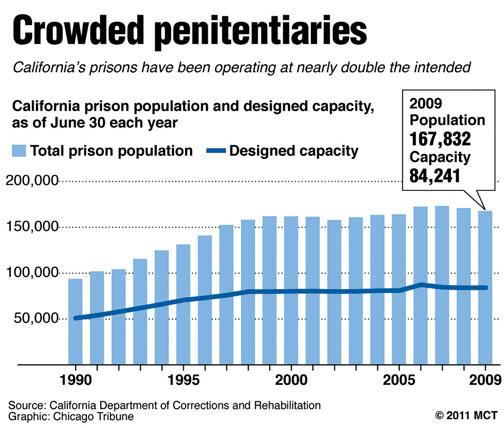Jam-packed in auditorium-like rooms with double-and triple-stacked bunk beds with few toilets and showers and little room to move around, hundreds of men live in confines so inadequate it borders on cruel and unusual punishment. This is the scene in almost every one of California’s prisons today.
According to the Huffington Post, overcrowding was such a big problem at the California Rehabilitation Facility in Riverside County in 2005 that hours went by before guards noticed an inmate who had been killed.
I imagine the average person feels a little torn as to how we should deal with the overcrowding issue in California’s prisons. Lush, cushy living quarters are not exactly what non-offending Americans envision for criminals, but cramming hundreds of men into a small space is just wrong.
The immediate issue is the direct violation of the detained prisoner’s Eighth Amendment right. Every citizen of the U.S. is supposed to be protected from “cruel and unusual punishments” that cause undue suffering or humiliation.
The governor’s office has been forced to take action to avoid legal repercussions because of the unconstitutionality of prisoners’ current situation.
California prisons are at nearly 150 percent capacity as of right now, according to Gov. Jerry Brown’s website. The website also supplies a list of changes required of the prison system since Arnold Schwarzenegger held office until last year. Since October 2011, the number of incarcerated individuals dropped by roughly 19,000 inmates after a law was passed moving less-serious offenders back to county jails to finish serving their time. That may sound like a lot, but the state needs to shed 17,000 more by June to reduce crowding—a goal the governor’s office doesn’t expect to meet.
A report by the Huffington Post said the “overflow beds” crammed into prisons accounted for more inmates than the entire populations of 25 other states. Instead of looking into releasing inmates to lower population rates, California contracted private prison entities outside the state and moved inmates to prisons in Arizona, Missouri and Oklahoma. These facilities are run by the private company Corrections Corporation of America, which the California Department of Corrections and Rehabilitation contracted in early 2006. CCA renewed and expanded contracts with CDCR in 2010 as well.
The prisons are not only out of state, but run by a corporation, not the government. If you know even a little about politics, this means CCA is in it for money and CDCR is paying a pretty penny to store felons in its facilities. This is not a cheap solution, nor is it convenient.
The prisons are bursting at the seams with criminals and California tax dollars are paying to house them in facilities it likely can’t afford and technically, the number of inmates is staying the same—it’s just spreading out.
As a partial solution, California voters passed Proposition 36 in November, reforming the three-strikes law to give non-violent offenders less serious sentences. This not only helps the future prison population, but also gives thousands of inmates who were handed down 25-to-life sentences a new sentencing hearing to lower their prison time. Additionally, the war on drugs has been a tough loss for U.S. law enforcement as a whole—three states recently passed pro-marijuana laws, showing the feds won’t win this war.
I don’t have exact statistics and I would bet officials wouldn’t want me to anyway, but I am willing to bet if we let all the minor drug offenders out of jails and prisons tomorrow, it would put a nice-sized dent in the overcrowding issue. Maybe I am just too liberal in my thinking, but smoking pot is hardly an offense worthy of a prison sentence.
California could help further ease crowding by reducing or even eliminating prison sentences for minor offenses, such as marijuana possession. A lot of money could be saved—money California’s strained budget desperately needs—with policies such as putting warrant sweeps on hold, giving probation to minor offenders and eliminating the practice of carting off prisoners to other states throughout the country.
The governor’s office has a tough decision to make, but it’s running out of time. Let the pot smokers and vandals out of jail to make room for the real convicts, cut funding for privately owned prisons and utilize available facilities for sex offenders and murderers. It won’t completely solve the overpopulation issue, but it’s a better start than what has been made so far.







